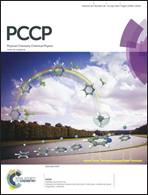Dissociation rates of H2 on a Ni(100) surface: the role of the physisorbed state
Abstract
The dissociation and recombination rates of physisorbed H2, and the total dissociation rate of gas phase H2 on the rigid Ni(100) surface, as well as the corresponding kinetic isotope effects, are calculated by using the quantum instanton method, together with path integral Monte Carlo and adaptive umbrella sampling techniques. Both the dissociation and recombination rates of physisorbed H2 are dramatically enhanced by the quantum motions of H2 at low temperatures, for instance, the quantum rates are 43 and 7.5 times larger than the classical ones at 200 K, respectively. For the dissociation of gas phase H2, at high temperatures, the H2 can fly over the physisorbed state and dissociate directly, however, at low temperatures, the H2 is first physisorbed and then dissociates under steady state approximation. The total dissociation rate of gas phase H2 can be expressed as a combination of the direct and steady state dissociation rates. It has the form of an inverted bell with a minimum value at about 400 K, and detailed analysis shows that the dissociation of gas phase H2 is dominated by a steady state process below 400 K, however, both the steady state and direct processes are important above 400 K. The calculated kinetic isotope effects reveal that H2 always has larger rates than D2 no matter which dissociative process they undergo.


 Please wait while we load your content...
Please wait while we load your content...